Enhancing Income as a Starting Point for Designing Sustainable Health Product-Service Systems for Chronically Ill Elderly in Rural Areas
Abstract
1. Introduction
2. Materials and Methods
2.1. Phase 1: Background Research
2.2. Phase 2: Construction of a Sustainable Health Product-Service System Design Model for Chronically Ill Elderly in Rural Areas
2.3. Phase 3: Validation of the Sustainable Health Product-Services System Design Model within a Project
2.4. Phase 4: Empirical Demonstration of the Model’s Practical Value
3. Model Construction
3.1. Findings from the Semi-Structured Interview
3.2. A Comparison of Three Design Models
3.3. Model Construction with the Focus Group
3.3.1. Organizing Stakeholders’ Interactions
3.3.2. Insight into the Experience
3.3.3. System Content Coding
- Stakeholders contributing to elderly income generation, such as poultry companies and a producer of smart traceable anklets.
- Stakeholders responsible for disease management payment, such as poultry companies and government institutions.
- Stakeholders engaged in disease management activities, comprising community clinics and hospitals.
- Stakeholders overseeing the overall process and regulations, including regulatory institutions that ensure the well-being of the elderly within the system.
4. The Sustainable Health Product-Service System Design (PSSD) Model
4.1. The Background Layer
4.2. The Stakeholder Layer
4.3. The Funding Layer
4.4. The Product Layer
4.5. The Service Layer
4.6. The Information Layer
5. The Evaluation of the System Design Model in a Real Case
5.1. Case Design—Application of the System Design Model in Liyang Town
5.1.1. Key Partnership Establishment
5.1.2. Cooperation with the “Smart Traceable Anklet” Company
5.1.3. Sales and Financial Distribution
5.1.4. Graded Treatment Model
5.1.5. Cost Coverage
5.2. Cross-Case Comparison
6. Conclusions and Discussion
Author Contributions
Funding
Institutional Review Board Statement
Informed Consent Statement
Data Availability Statement
Acknowledgments
Conflicts of Interest
References
- WHO. UN Decade of Healthy Ageing: Plan of Action 2021–2030; WHO: Geneva, Switzerland, 2020. Available online: https://cdn.who.int/media/docs/default-source/decade-of-healthy-ageing/decade-proposal-final-apr2020-en.pdf?sfvrsn=b4b75ebc_28&download=true (accessed on 5 May 2023).
- Boutayeb, A.; Boutayeb, S. The Burden of Non Communicable Diseases in Developing Countries. Int. J. Equity Health 2005, 4, 2. [Google Scholar] [CrossRef] [PubMed]
- Sambamoorthi, U.; Tan, X.; Deb, A. Multiple Chronic Conditions and Healthcare Costs among Adults. Expert Rev. Pharmacoecon. Outcomes Res. 2015, 15, 823–832. [Google Scholar] [CrossRef] [PubMed]
- Zhong, Z.; Lin, L.; Yang, Y. Study on the Health Status and Health Service Utilization for the Rural Elderly in the Metropolitan Suburb During the Urbanization Process: A Case for Mingxing Village, Guangzhou. Sustainability 2020, 12, 3560. [Google Scholar] [CrossRef]
- Li, X.; Cai, L.; Cui, W.; Wang, X.; Li, H.; He, J.; Golden, A.R. Association of Socioeconomic and Lifestyle Factors with Chronic Non-Communicable Diseases and Multimorbidity among the Elderly in Rural Southwest China. J. Public Health 2020, 42, 239–246. [Google Scholar] [CrossRef] [PubMed]
- Zhou, M.; Sun, X.; Huang, L. Chronic Disease and Medical Spending of Chinese Elderly in Rural Region. Int. J. Qual. Health Care 2021, 33, mzaa142. [Google Scholar] [CrossRef]
- Dai, B. The Old Age Health Security in Rural China: Where to Go? Int. J. Equity Health 2015, 14, 119. [Google Scholar] [CrossRef]
- St Sauver, J.L.; Boyd, C.M.; Grossardt, B.R.; Bobo, W.V.; Finney Rutten, L.J.; Roger, V.L.; Ebbert, J.O.; Therneau, T.M.; Yawn, B.P.; Rocca, W.A. Risk of Developing Multimorbidity across All Ages in an Historical Cohort Study: Differences by Sex and Ethnicity. BMJ Open 2015, 5, e006413. [Google Scholar] [CrossRef]
- Thorpe, K.E.; Allen, L.; Joski, P. The Role of Chronic Disease, Obesity, and Improved Treatment and Detection in Accounting for the Rise in Healthcare Spending Between 1987 and 2011. Appl. Health Econ. Health Policy. 2015, 13, 381–387. [Google Scholar] [CrossRef]
- Bhattacharya, R.; Ajmera, M.; Bhattacharjee, S.; Sambamoorthi, U. Use of Antidepressants and Statins and Short-Term Risk of New-Onset Diabetes among High Risk Adults. Diabetes Res. Clin. Pract. 2014, 105, 251–260. [Google Scholar] [CrossRef]
- Huang, F.-H. Explore Home Care Needs and Satisfaction for Elderly People with Chronic Disease and Their Family Members. Procedia Manuf. 2015, 3, 173–179. [Google Scholar] [CrossRef]
- Zhu, B.; Ning, W.; Zhang, J.; Li, H.; Zhang, N.; He, R.; Mao, Y. Policy Analysis of Basic Health Insurance Chronic Disease and Special Critical Diseases Security in China: Based on Content Analysis. Chin. J. Health Policy 2022, 15, 43–49. [Google Scholar]
- Fu, M.; Luo, J. Design of an Intelligent Intravenous Infusion Hemostat for Elderly Patients with Chronic Diseases Based on Image Recognition Technology. In Digital Human Modeling and Applications in Health, Safety, Ergonomics and Risk Management. Health, Operations Management, and Design; Duffy, V.G., Ed.; Lecture Notes in Computer Science; Springer International Publishing: Cham, Switzerland, 2022; pp. 41–53. [Google Scholar] [CrossRef]
- van der Weegen, S.; Verwey, R.; Spreeuwenberg, M.; Tange, H.; van der Weijden, T.; de Witte, L. The Development of a Mobile Monitoring and Feedback Tool to Stimulate Physical Activity of People With a Chronic Disease in Primary Care: A User-Centered Design. JMIR MHealth UHealth 2013, 1, e2526. [Google Scholar] [CrossRef] [PubMed]
- Sun, X.; Li, Z.; Yang, M. Design and Research of Intelligent Products for the Management of Chronic Diseases of the Elderly. In Human-Computer Interaction. Human Values and Quality of Life; Kurosu, M., Ed.; Lecture Notes in Computer Science; Springer International Publishing: Cham, Switzerland, 2020; pp. 165–177. [Google Scholar] [CrossRef]
- Miller, A.S.; Cafazzo, J.A.; Seto, E. A Game Plan: Gamification Design Principles in mHealth Applications for Chronic Disease Management. Health Inform. J. 2016, 22, 184–193. [Google Scholar] [CrossRef] [PubMed]
- Shao, W.; Fu, J.; Dai, Y. Design of Medicine Box for the Elderly with Chronic Diseases. In Advances in Human Factors and Ergonomics in Healthcare and Medical Devices; Kalra, J., Lightner, N.J., Taiar, R., Eds.; Lecture Notes in Networks and Systems; Springer International Publishing: Cham, Switzerland, 2021; pp. 443–449. [Google Scholar] [CrossRef]
- Iii, C.C.W.; Peeples, M.M.; Kouyaté, R.C.A. Evidence-Based mHealth Chronic Disease Mobile App Intervention Design: Development of a Framework. JMIR Res. Protoc. 2016, 5, e4838. [Google Scholar] [CrossRef]
- Gray, D.E. Doing Research in the Real World, 3rd ed.; Reprinted; SAGE: London, UK, 2014. [Google Scholar]
- Banbury, A.; Pedell, S.; Parkinson, L.; Byrne, L. Using the Double Diamond Model to Co-Design a Dementia Caregivers Telehealth Peer Support Program. J. Telemed. Telecare 2021, 27, 667–673. [Google Scholar] [CrossRef]
- Kan, J.; Gero, J. Using the FBS Ontology to Capture Semantic Design Information in Design Protocol Studies. In About Designing; CRC Press: Boca Raton, FL, USA, 2009; pp. 213–229. [Google Scholar]
- Hussain, J.; Azhar, Z.; Ahmad, H.F.; Afzal, M.; Raza, M.; Lee, S. User Experience Quantification Model from Online User Reviews. Appl. Sci. 2022, 12, 6700. [Google Scholar] [CrossRef]
- Søvold, L.E.; Solbakken, O.A. The User Experience Framework for Health Interventions. Nord. Psychol. 2022, 74, 279–300. [Google Scholar] [CrossRef]
- Liu, R.; Tang, S.; Wang, Y.; Dong, Y.; Hou, T.; Ren, Y.; Qin, Y.; Cong, L.; Qiu, C.; Du, Y. Associations of Sleep Characteristics with Mild Cognitive Impairment and Dementia among Chinese Elderly People Living in a Rural Area: A Population-based Study: Epidemiology/Risk and Protective Factors in MCI and Dementia. Alzheimers Dement. 2020, 16, e042382. [Google Scholar] [CrossRef]
- Li, T.; Guan, L.; Wang, X.; Li, X.; Zhou, C.; Wang, X.; Liang, W.; Xiao, R.; Xi, Y. Relationship Between Dietary Patterns and Chronic Diseases in Rural Population: Management Plays an Important Role in the Link. Front. Nutr. 2022, 9, 866400. [Google Scholar] [CrossRef]
- Kwon, J.; Choi, Y.; Hwang, Y. Enterprise Design Thinking: An Investigation on User-Centered Design Processes in Large Corporations. Designs 2021, 5, 43. [Google Scholar] [CrossRef]
- Zhou, F.; Ji, Y.; Jiao, R.J. Prospect-Theoretic Modeling of Customer Affective-Cognitive Decisions Under Uncertainty for User Experience Design. IEEE Trans. Hum.-Mach. Syst. 2014, 44, 468–483. [Google Scholar] [CrossRef]
- Pan, C.; Fan, Q.; Yang, J.; Deng, D. Health Inequality Among the Elderly in Rural China and Influencing Factors: Evidence from the Chinese Longitudinal Healthy Longevity Survey. Int. J. Environ. Res. Public Health 2019, 16, 4018. [Google Scholar] [CrossRef] [PubMed]
- Annamalai Vasantha, G.V.; Hussain, R.; Cakkol, M.; Roy, R. Product-Service Systems Design Using Stakeholders’ Information. In CIRP Design 2012; Chakrabarti, A., Ed.; Springer: London, UK, 2013; pp. 353–366. [Google Scholar] [CrossRef]
- Santamaria, L.; Escobar-Tello, C.; Ross, T. Switch the Channel: Using Cultural Codes for Designing and Positioning Sustainable Products and Services for Mainstream Audiences. J. Clean. Prod. 2016, 123, 16–27. [Google Scholar] [CrossRef]
- Guzzo, D.; Trevisan, A.H.; Echeveste, M.; Costa, J.M.H. Circular Innovation Framework: Verifying Conceptual to Practical Decisions in Sustainability-Oriented Product-Service System Cases. Sustainability 2019, 11, 3248. [Google Scholar] [CrossRef]
- Marzouk, M.; Hanafy, M. Modelling Maintainability of Healthcare Facilities Services Systems Using BIM and Business Intelligence. J. Build. Eng. 2022, 46, 103820. [Google Scholar] [CrossRef]
- García Lechuga, A.; Cortés Robles, G.; Arredondo Soto, K.C.; Miranda Ackerman, M.A. The Integration of the Business Model Canvas and the Service Blueprinting to Assist the Conceptual Design of New Product-Service Systems. J. Clean. Prod. 2023, 415, 137801. [Google Scholar] [CrossRef]
- Liu, J.; Wu, J.; Mao, Y. Research on Health Services Need and Utilization of the Rural Elderly Left at Home in Shaanxi Province, China. Value Health 2014, 17, A797. [Google Scholar] [CrossRef][Green Version]
- Azzine Shiratori, E.K.; Hofmann Trevisan, A.; Mascarenhas, J. The Customer Journey in a Product-Service System Business Model. Procedia CIRP 2021, 100, 313–318. [Google Scholar] [CrossRef]
- L’Heureux, T.; Parmar, J.; Dobbs, B.; Charles, L.; Tian, P.G.J.; Sacrey, L.-A.; Anderson, S. Rural Family Caregiving: A Closer Look at the Impacts of Health, Care Work, Financial Distress, and Social Loneliness on Anxiety. Healthcare 2022, 10, 1155. [Google Scholar] [CrossRef]
- Hemavathy, J. An Effectiveness of Need-Based Intervention on Level of Depression, Family Support, Quality of Life among Elderly Clients with Depression in Selected Rural Population. Master’s Thesis, Omayal Achi College of Nursing, Chennai, India, 2014. Available online: http://repository-tnmgrmu.ac.in/2711/ (accessed on 13 August 2023).
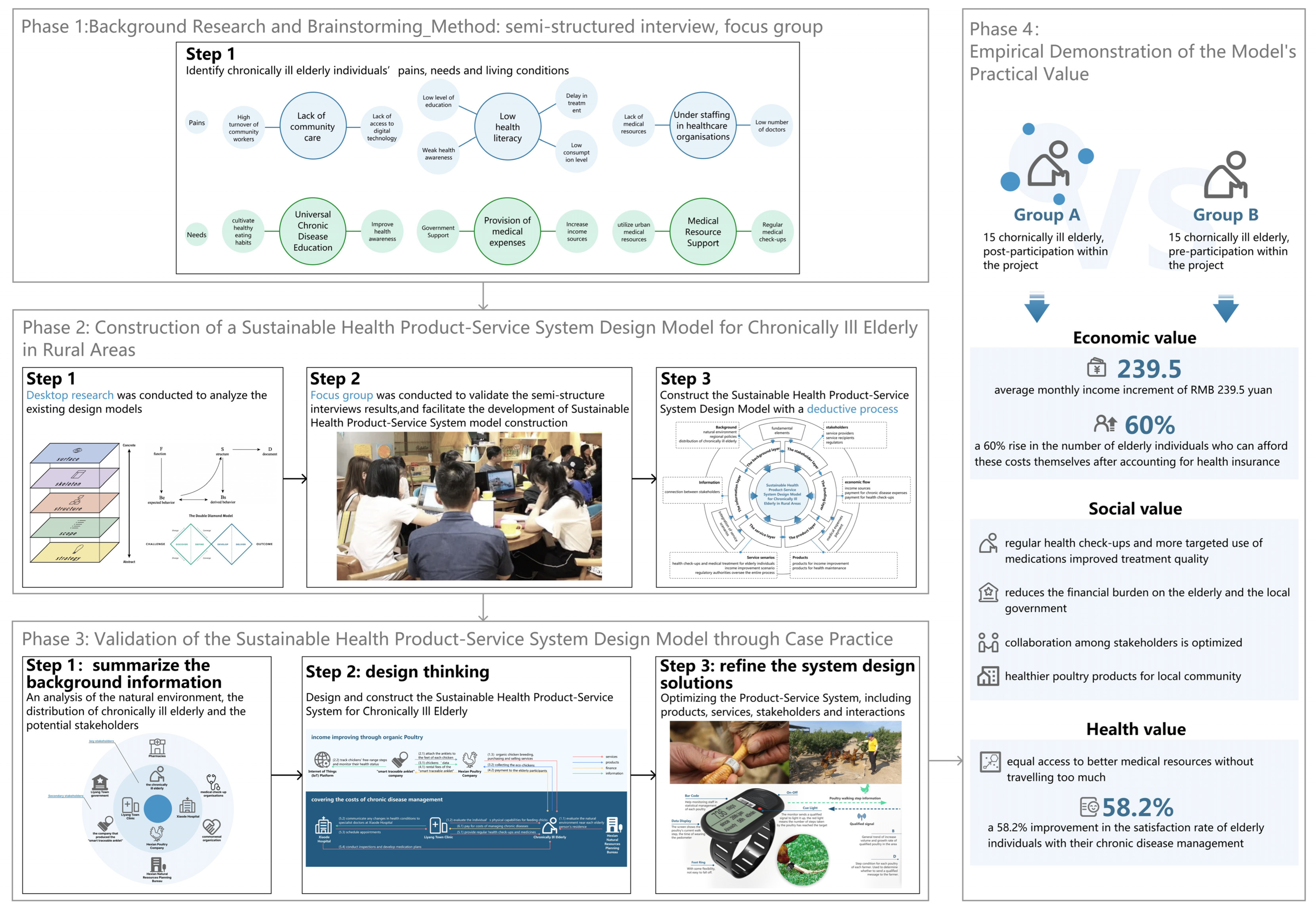
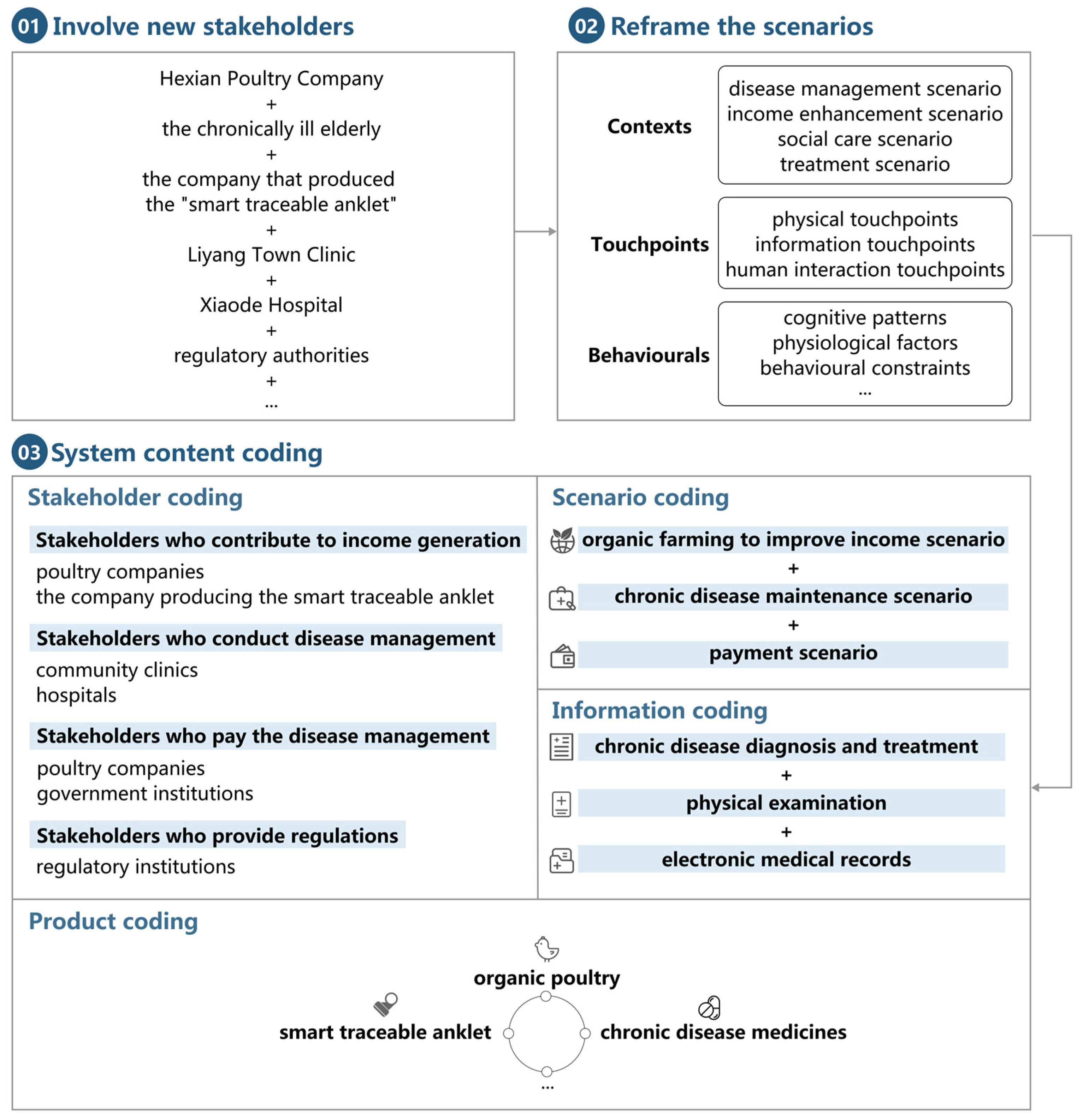
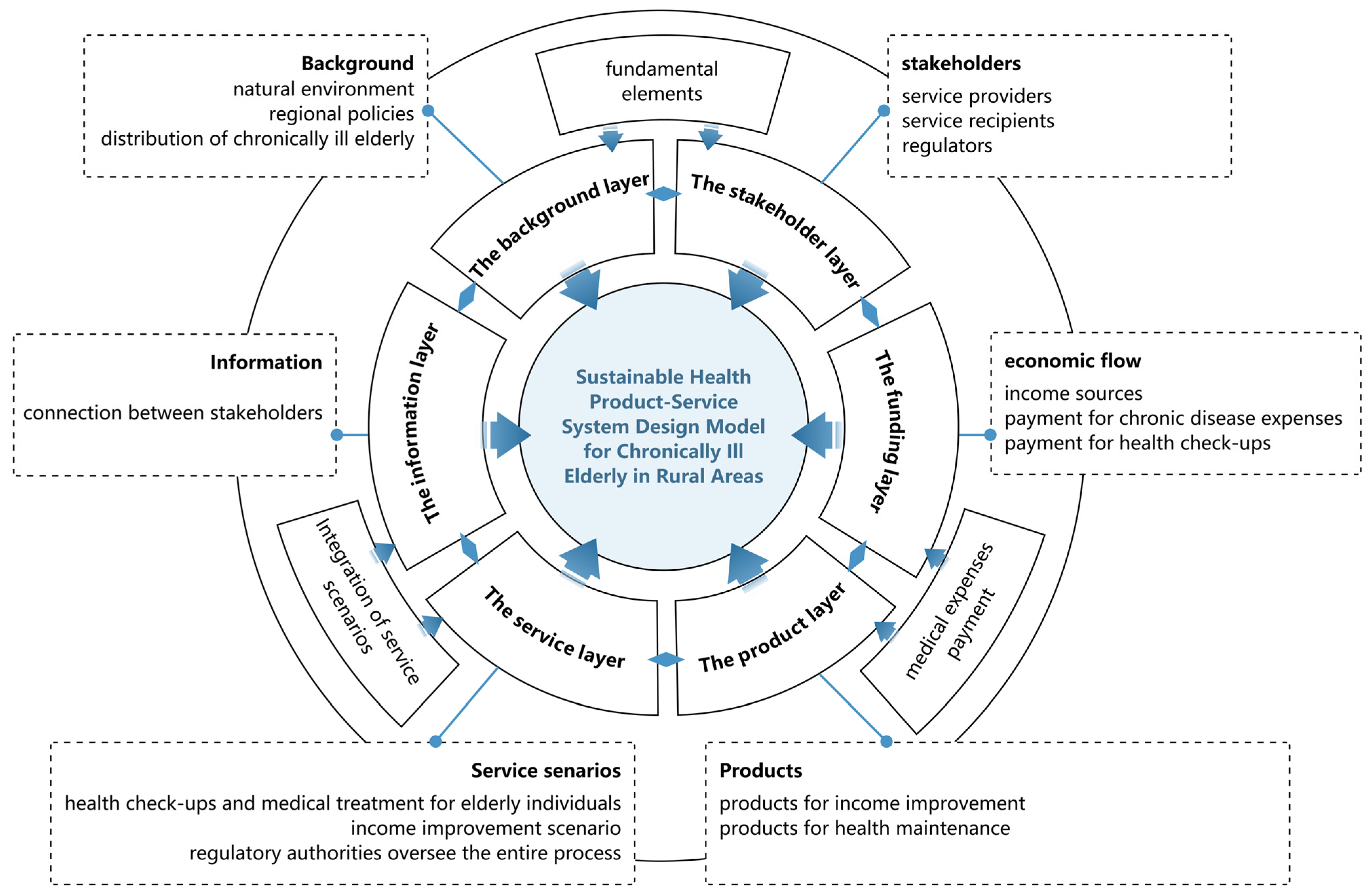
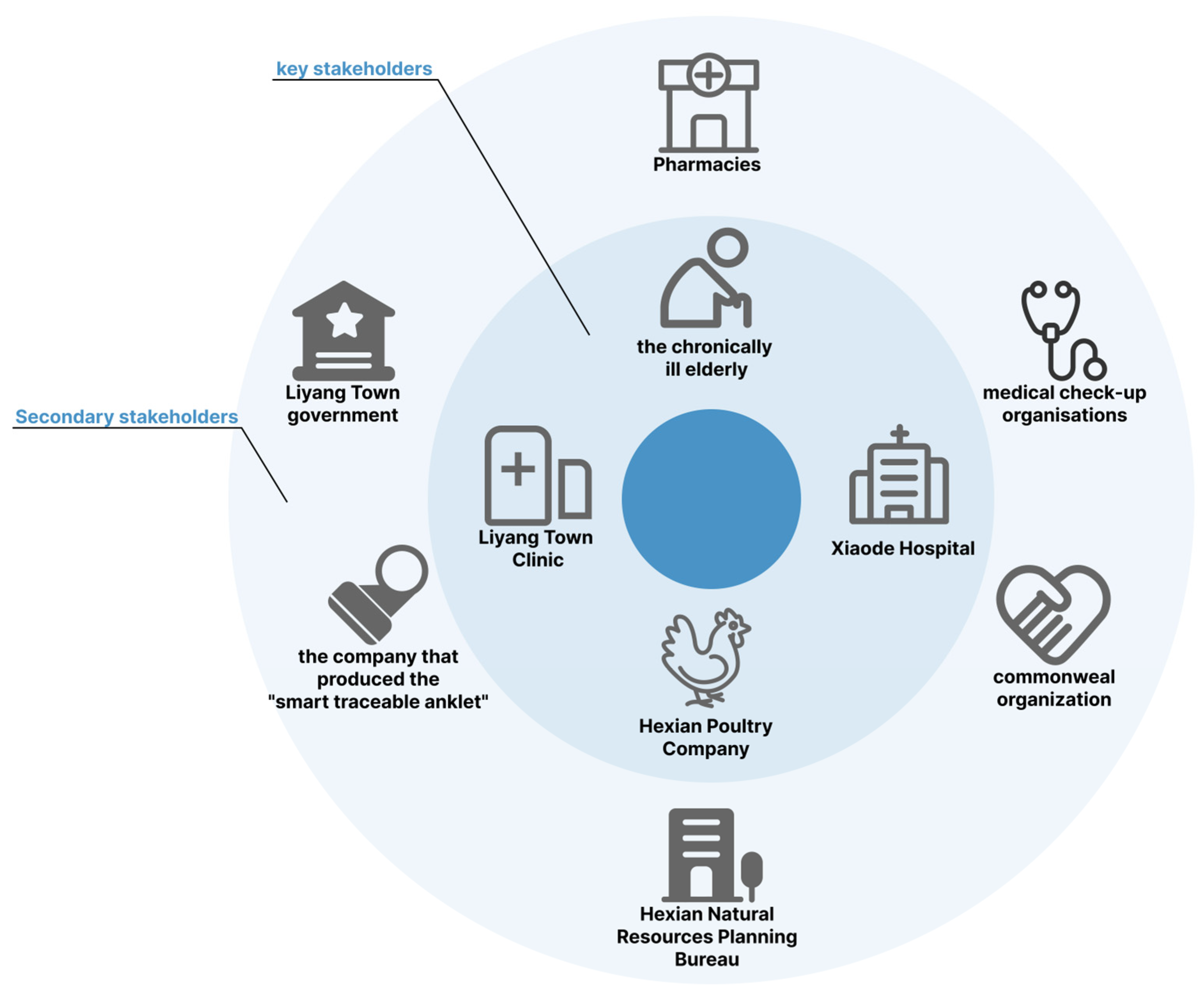
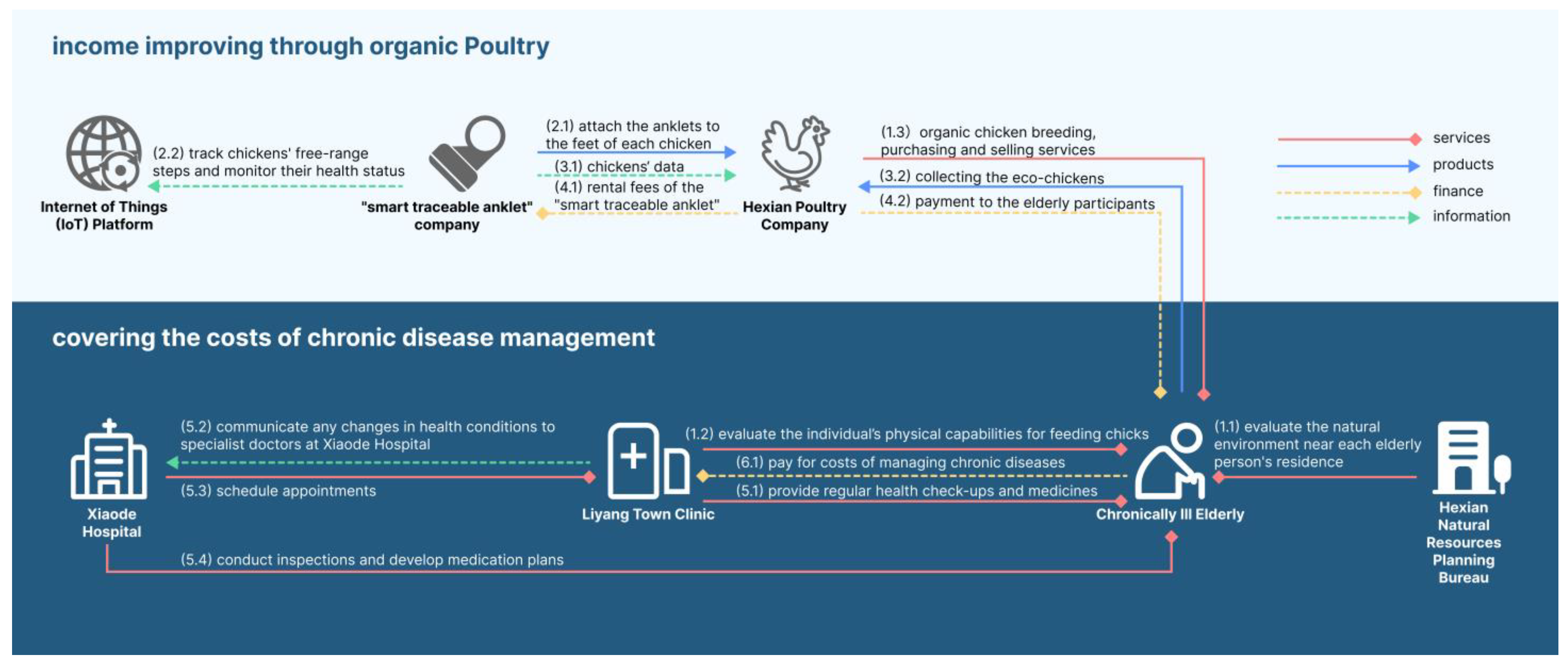
Disclaimer/Publisher’s Note: The statements, opinions and data contained in all publications are solely those of the individual author(s) and contributor(s) and not of MDPI and/or the editor(s). MDPI and/or the editor(s) disclaim responsibility for any injury to people or property resulting from any ideas, methods, instructions or products referred to in the content. |
© 2023 by the authors. Licensee MDPI, Basel, Switzerland. This article is an open access article distributed under the terms and conditions of the Creative Commons Attribution (CC BY) license (https://creativecommons.org/licenses/by/4.0/).
Share and Cite
Wang, X.; Yang, D.; Zha, L.; Liao, B. Enhancing Income as a Starting Point for Designing Sustainable Health Product-Service Systems for Chronically Ill Elderly in Rural Areas. Sustainability 2023, 15, 14404. https://doi.org/10.3390/su151914404
Wang X, Yang D, Zha L, Liao B. Enhancing Income as a Starting Point for Designing Sustainable Health Product-Service Systems for Chronically Ill Elderly in Rural Areas. Sustainability. 2023; 15(19):14404. https://doi.org/10.3390/su151914404
Chicago/Turabian StyleWang, Xingyu, Dongfang Yang, Li Zha, and Binzhou Liao. 2023. "Enhancing Income as a Starting Point for Designing Sustainable Health Product-Service Systems for Chronically Ill Elderly in Rural Areas" Sustainability 15, no. 19: 14404. https://doi.org/10.3390/su151914404
APA StyleWang, X., Yang, D., Zha, L., & Liao, B. (2023). Enhancing Income as a Starting Point for Designing Sustainable Health Product-Service Systems for Chronically Ill Elderly in Rural Areas. Sustainability, 15(19), 14404. https://doi.org/10.3390/su151914404







